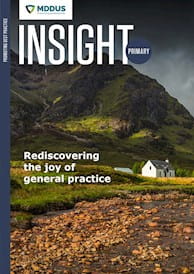GPs and primary care staff have seen some far-reaching changes in the way healthcare is delivered since the first Covid-19 lockdown. Practices then had no choice but to adopt new operational procedures, using often unfamiliar technologies to facilitate access to remote care and other services for patients over the course of the pandemic.
Many took necessary leaps into new ways of working that, although on the horizon, seemed a distance away, and which normally would have involved a cautious lead-in to ensure processes were planned, risk assessed, and that patient communications and team training were in place.
Fast forward to today and some of these new ways of working have been ‘paused’. For example, we’ve seen practices have to withdraw access to online consultations due to spikes in use by patients, leading to capacity issues and the risk that clinicians might not be able to respond in safe timeframes.
Some practices have also reduced or removed routine access to remote consultations (by video or telephone) as evidence mounts that for some patients, in some circumstances, these consultations are less efficient (taking longer with extra risks to manage) or indeed are inappropriate to meet patient need in an (almost) post-pandemic world.
However, many of the new procedures and systems adopted remain in place, and for good reason aren’t going anywhere, anytime soon. Further, some are now being expanded to encompass more areas of service delivery, as they are felt to add value or have resulted in efficiencies which support strained practice teams.
In the midst of the pandemic, regulators were keen to support continuing healthcare and so provided reassurances to clinicians and practices that the challenging circumstances at the time would be taken into consideration should patient harm arise. Now though, as procedures evolve into everyday practice, it is important that risk assessments are conducted to ensure they are safe and appropriate to meet ongoing care needs.
Emerging models of care
There are many examples of emerging practice with new operational procedures and technologies being used by both practices and patients themselves. As well as being designed to optimise delivery of care, these can support patients to be more aware of and involved in their own health management, which has been shown to improve clinical outcomes. For example, we have had advice requests from MDDUS members in relation to:
- Transformation of patient monitoring systems to allow capture of key information by remote means, with in-person reviews scheduled only where necessary or indicated.
- Integration of readings and alerts from patients’ wearable devices (designed to promote self-management of conditions) into patient records to better inform treatment decisions.
- Setting up synchronous and asynchronous virtual patient groups to facilitate group learning, treatment, support and management of specific clinical conditions.
Generally, it is helpful to consider potential risks in emerging models of care with a focus on regulatory guidance, data protection and confidentiality, scope and purpose of the procedures and any necessary training for staff and communication with patients. Adequate documentation is also necessary to support evidence of good practices.
Case study: virtual care and support group for diabetics
Consider the example of a practice wishing to set up a virtual group to enhance the care and support provided to newly diagnosed diabetics.
Embracing new technology in patient care can undoubtedly have benefits for both patients and clinicians. Technologies that work on a one-to-one basis, with safeguards in place, can be an excellent way of improving access, efficiency and clinical outcomes. However, they are not without risks – and where the technology operates on a group-wide basis, the risks are significantly greater and require very careful consideration.
Issues of concern in this type of scenario relate to:
- consent
- confidentiality
- data protection responsibilities
- patient understanding or expectations of the purpose and remit of the group.
These areas are important starting points (among others) to consider for any new model of care. Some questions to consider include the following.
Ensuring informed consent
Have patients been fully informed of the proposed scope, purpose and practical arrangements around the groups’ functioning, and any necessary information-sharing aspects of participating? Elements such as these will determine the robustness of consent obtained to participate. It is also important to ensure that patients understand that their care will not be compromised should they decide not to consent to joining the group.
Consenting to the sharing of medical information should also be considered – for example there might be the risk that a clinician inadvertently shares additional clinical information about a patient in response to a question from a patient in the group setting.
Maintaining confidentiality of participants
Some virtual patient groups might include a round robin of individual consultations as a section of their meeting, where patients can listen in to each other’s experiences and the clinical advice provided. This can reinforce the learning process and allow for more informed support outside the ‘walls’ of the group.
In this scenario it would be important to have a strict confidentiality agreement, asking participants to ensure they maintain the confidentiality of others. This would include ensuring no one in their household is able to overhear the groups’ conversation: for example emphasising the use of headsets and a private space.
Establishing ground rules
Where a group is going to be interacting asynchronously (often via platforms like closed Facebook or WhatsApp groups) it will also be important to make clear:
- The behaviours expected of group members (respect, confidentiality, scope of communications/purpose, etc).
- That any inappropriate posts on the groups' virtual platform will be deleted.
- That participants have a responsibility to each other, to take steps to prevent access by third parties.
- That no information should be screenshotted or shared outside the group.
Actions by participants are almost impossible to police, but if something does go wrong it will be important to have demonstrated that these risks (and others relevant to the service or process at play) have been considered and mitigating actions in the form of group rules have been ‘signed up to’ by participants.
Maintaining professional boundaries
For asynchronous groups, it is also important to consider safeguarding the personal information of the participating clinician. Being in an online group means that the personal contact details and location information of the clinician could be available to patients. This could lead to the potential for patients to contact the clinician outside of the group chat, without going through normal practice channels (see GMC guidance on Maintaining a professional boundary between you and your patient and Doctors’ use of social media).
Documenting decisions
Document all discussions, risk assessments and decisions in regard to the new patient group and keep in a dedicated file in case the practice is later asked to justify their actions.
All the above considerations could probably be retrospectively applied to existing procedures but it is obviously better, where possible, to have safety principles designed into the planning and development process.
Variability of risk
The risks identified and strategies to mitigate these are obviously going to be different depending on the operational procedures being implemented, the expertise/experience of your team, patient specifics and the functionality (including limitations) of the systems available. It is therefore important to seek advice from MDDUS on any areas of uncertainty or concern by contacting advice@mddus.com.
I hope that exploration of the considerations above will be a useful prompt to help you examine principles that can be applied to risk assessment of your own procedures or services.
ZOOM course: Practice and patient use of technology in practice
An interactive, case-based, course designed for practice managers, GPs and other leads in a primary care setting. The content is based on advice calls and cases related to practice and patient use of technology, and the regulatory, legal, scope and process risks associated with a range of scenarios.
Date and time: Thu, 20 April 2023, 09:30 – 12:30 BST
This page was correct at the time of publication. Any guidance is intended as general guidance for members only. If you are a member and need specific advice relating to your own circumstances, please contact one of our advisers.
Read more from this issue of Insight Primary

Save this article
Save this article to a list of favourite articles which members can access in their account.
Save to library


